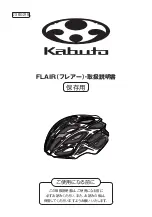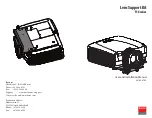
3
EN
– Sensitive objects such as cameras, DVD players etc. must
not be kept in the stowage box near the control unit or the
motor cables, as the powerful electromagnetic fields may
damage them.
– The empty weight of the vehicle is increased by the weight
of the Mover XT / XT2, thus reducing the vehicle's payload.
– Remove the plug / adapter from the safety socket after
manoeuvring, otherwise the battery will be discharged.
Quiescent current with plug / adapter inserted < 80 mA.
Quiescent current with plug / adapter unplugged < 150 µA.
– Inspect the system for damage before use.
The system must not be used if it is damaged.
General instructions
The Mover XT has been designed to cope with inclines of up
to approx. 25 % bearing a gross weight of 1200 kg or 13 %
bearing a gross weight of 2300 kg on a suitable surface.
The Mover XT2 has been designed to cope with inclines of up
to approx. 25 % bearing a gross weight of 1200 kg or 10 %
bearing a gross weight of 2400 kg on a suitable surface.
Depending on the weight of the caravan, the Mover XT / XT2
may not be able to overcome obstacles more than about
3 cm in height without auxiliary equipment (please use ascent
chocks).
As a result of the characteristic properties of a radio signal, it
may be interrupted by terrain / objects. This reduces recep-
tion quality in small areas around the caravan, as a result of
which the operation of the Mover XT / XT2 may be briefly
interrupted.
When the Mover XT / XT2 is switched off using the re-
mote control, the control unit remains in standby. In or-
der to switch off completely the battery must be disconnected
or an isolating switch installed.
Batteries
Recommended battery capacities
Button cell technology
at least 38 Ah
Gel / AGM
at least 48 Ah
Lead-acid battery (liquid electrolyte)
at least 75 Ah
Starter batteries are not suitable
Batteries with greater capacity allow the equipment to
be used for longer.
Charger
For optimum battery charging we recommend the Truma
BC 10 charger, which is suitable for all battery types up to
200 Ah.
Battery care (including maintenance-free
batteries)
In order to achieve a long battery service life, attention must
be paid to the following points:
– Batteries should be fully charged before and after removing
power,
– for stationary periods of longer than 24 hours, interrupt
power circuit (e.g. using circuit breaker or by disconnecting
the battery poles),
– for longer stationary periods, the battery must be discon-
nected and charged for 24 hours at least every 12 weeks.
In winter, store the fully charged battery in a cool and
frost-free place and recharge at regular intervals (every
12 weeks).
Notes for handling batteries
– When handling batteries, pay attention to the manufac-
turer’s safety instructions and data sheets
– Ensure that the terminal clamps are secure.
– Secure battery poles with protection caps in order to pre-
vent a short circuit
– When removing the battery, first disconnect the earth con-
nection (negative terminal), followed by the positive termi-
nal. When installing the battery, first connect the positive
terminal followed by the negative terminal.
Function description
Always observe the operating instructions and the
“Safety instructions” prior to starting!
The vehicle owner
is responsible for correct operation of the device.
Please note that the Mover XT is only suitable for sin-
gle-axle trailers, while the Mover XT2 is only suitable
for dual-axle trailers.
The Mover XT / XT2 is a manoeuvring system which allows
a caravan to be manoeuvred without the aid of the towing
vehicle.
It consists of two separate drive assemblies, each with its
own 12 V DC motor. These units are mounted on the frame
of the vehicle in the immediate vicinity of the wheels, and are
connected by a lateral bar.
Once the drive rollers have been engaged using the remote
control, the Mover XT / XT2 is ready for operation. It is op-
erated exclusively via the remote control, which transmits
radio signals to the control unit. A separately installed 12 V
lead-acid battery or suitable lead-gel battery (not supplied)
provides the control unit with electrical power.




























